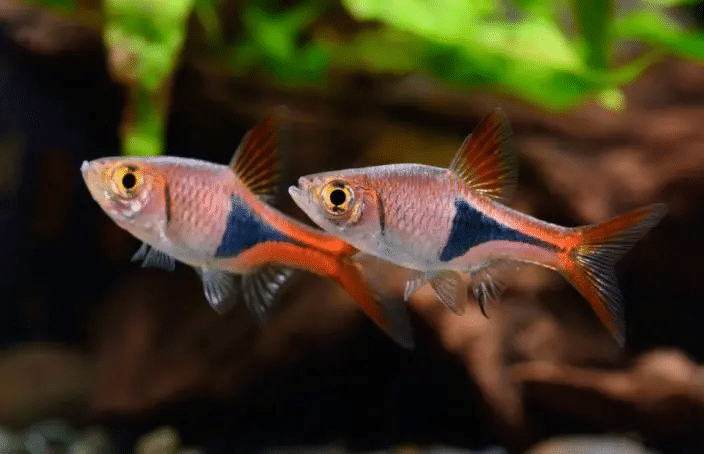Little Gems
Rasboras are schooling fish in the family Cyprinidae, which means they are related to barbs, danios, goldfish and koi. They are peaceful, colourful fish, and most species grow to less than 10cm, making them ideal for small to mid-size aquariums. Popular species like harlequin, lambchop, scissortail, lampeye (eyespot) and brilliant (also called redtail or black line) rasboras typically do not get larger than 5cm. They are active and hardy, making them good beginner fish for 37L aquariums or larger.
Smaller species such as dwarf emerald rasboras and various species of Boraras are relatively new to the aquarium hobby. Most of these brilliantly coloured fish max out at 2.5cm or less and are perfect inhabitants for desktop and nano aquariums of 37L. Rasboras are best purchased in groups of 7 or more, although groups of 25 or more are a sight to behold!
A Rasbora's Natural Habitat
Rasboras are found throughout south and southeast Asia, including southeast China. They mostly inhabit gently flowing forest streams, but also occur in floodplains during the wet season. They prefer shallow water and abundant aquatic plant growth. The water is often stained brown from tannins released by leaves and other organic matter, and the pH can be as low as 4.0 in some habitats. Light is often subdued due to overhanging vegetation.
Water Requirements for Rasboras
While some rasboras, especially members of the genus Boraras, are collected in the wild where the water is very soft and slightly acidic, the majority of aquarium species sold today are raised commercially in water with higher pH and alkalinity than their native environment. For these fish, pH should be between 6.8 and 7.8, alkalinity between 3° and 8° dkH (50 ppm to 140 ppm), and temperature between 23° and 26° C. If the aquarium is kept in rooms below 23°, use an Aquarium Heater to maintain the correct temperature. Wild-caught fish prefer a pH of 5.0 to 7.0 and KH between 1°and 3° (20 ppm to 50 ppm). Maintain good filtration and change 10% of the water weekly or 25% twice a month using an Aquarium Water Changer or Siphon Vacuum Gravel Cleaner. Do not forget to treat tap water with Water Conditioner before refilling your aquarium!
Housing Requirements for Rasboras
Rasboras are happiest in a well planted aquarium and they do best in groups of 7 or more. They will be less stressed and show their best colours in a well-decorated aquarium with dark substrate. The filter should provide a gentle current to simulate the slow-moving streams they live in in nature. Keep a secure lid on the aquarium to prevent them from jumping out.
Rasboras Behavior/Compatibility
Rasboras are peaceful and most species get along well with similarly sized community fish. Depending on species, they can be housed with other rasboras, small tetras, croaking, sparkling and chocolate gouramis, celestial danios, pentazona barbs, guppies and platies. Suitable bottom dwellers include otocinclus, kuhli and other small peaceful loaches, and corydoras catfish. Dwarf rasboras such as those in the genus Boraras are best kept in a species tank, but due to their small size, they are one of the few fish species that can also be housed with dwarf freshwater shrimp. Always consult an aquarium expert before buying any new fish for your aquarium.
What do Rasboras Eat?
Most rasboras are considered micro-predators, meaning they feed on small insects, zooplankton, worms and tiny crustaceans in nature. They will thrive on Tropical Flakes, Color Flakes, Tropical Granules and Shrimp Pellets. For extremely small species, crush dried foods to match their mouth size. Frozen and live foods can also be fed as treats or to help induce spawning. For best results, rotate their diet daily and feed only what they can consume in 2 to 3 minutes, once or twice a day.
Rasboras Breeding Level – Difficult
Most rasbora species kept by aquarists are egg scatterers that distribute their eggs among plants and provide no parental care. Harlequin, lambchop and a few other species are known to attach their eggs to the underside of plant leaves. Healthy adult fish kept in mature, well-planted aquariums will sometimes produce young with no assistance from the aquarium owner.

